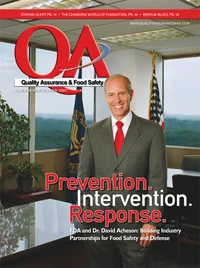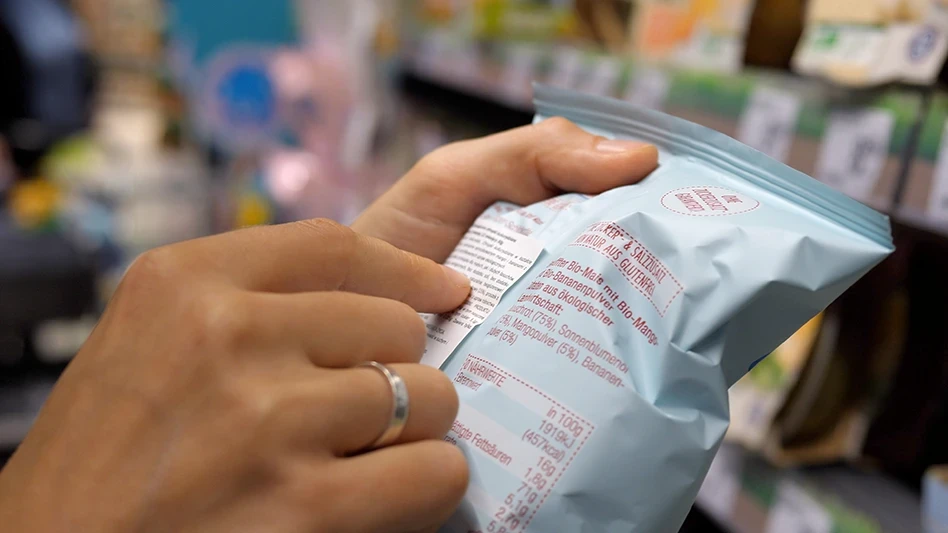Biofilms are much like ants. To study ants, you can scrutinize and dissect the individual, counting its legs, identifying its unique characteristics; you will learn a lot about the ant, but you will miss out on the incredible depth of its communities, its social nature, or, as Montana State University Professor Phil Stewart describes it, the “shockingly larger-scale coordinated effort that ants working together can pull off.”
Like an ant colony made up of different types (workers, queen, larvae, etc.), the biofilm that can so readily form in your plant and on your equipment is actually a colony of varying types of bacteria that come together in a social network, Stewart said. It is a colony that has not only grouped together, but that can communicate as well. Through cell-to-cell communication of bacterial exchange and “signals,” the cells can sense one another’s presence and numbers. “When they accumulate enough, they know they have a lot of company and can start to form biofilm,” he explained.
Stewart is the Director of the Center for Biofilm Engineering (CBE) and a professor of Chemical and Biological Engineering at Montana State University. Established in 1990 as a National Science Foundation Engineering Research Center, CBE’s mission is to advance the basic knowledge, technology, and education required to understand, control and exploit biofilm processes.
Defined by Merriam-Webster’s Medical Dictionary as “a thin usually resistant layer of microorganisms (as bacteria) that form on and coat various surfaces,” biofilm can form on any surface exposed to bacteria and some amount of water. As further described by CBE, biofilm is composed of millions of microorganisms (bacteria, fungi, algae and protozoa) that accumulate on surfaces and excrete a glue-like substance that anchors them to that surface. Once anchored, the biofilm microorganisms carry out a variety of detrimental or beneficial reactions, depending on the surrounding conditions.
THE BIOFILM LIFE CYCLE. The biofilm-forming microorganisms can create quite an elaborate structure “with lots of variety and sophistication,” Stewart said. The biofilm life cycle is made up of three steps:
- attachment — Bacteria adhere to surfaces in aqueous environments and begin to excrete a slimy, glue-like substance that can anchor them to a vast variety of materials. The biofilm can be formed by a single bacterial species, but more often it will consist of many species.
- colony growth — Through their communication, the sessile, or fixed, cells of a biofilm build discrete microcolonies separated by channels, allowing fluids to move through to carry in nutrients and carry out wastes. As it grows, the biofilm forms a protective, resistant layer on its surface, protecting the bacteria within. Thus, like ants and humans, bacteria find that becoming part of the community — in this case, the biofilm — is advantageous because it provides for the basics of life: nutrients and shelter.
- detachment — Biofilm bacteria can move in a variety of ways: Collectively — by rippling or rolling across the surface, or by detaching in clumps. Individually — through a “swarming and seeding” dispersal. It is through this detachment that the bacteria then contaminate the surrounding fluid or space.
Like ants, however, as much as we know about biofilm habits and communities, there is still plenty to study and learn — particularly as relates to bacterial impact and management.
BIOFILM'S UNKNOWNS. The term biofilm has been around for about 30 years, Stewart said, during which time related research and papers have increased tremendously, with significant growth occurring in the last 10 years.
“I think there is a growing awareness in the (food) industry that biofilms are real — and that they’re tough,” he said. “And we know that once microbes band together in a biofilm, they are resistant.”
And biofilms are an issue, in general, causing surface corrosion, implicated by the Centers for Disease Control and Prevention for 65 percent of human bacterial infections, and costing the U.S. billions of dollars annually in equipment damage, product contamination, energy losses and medical infections.
What we don’t know for sure, Stewart said, is if foodborne pathogen-harboring biofilms really are an issue. Is foodborne illness caused by bacteria released from biofilm, or did it originate from another source? We know that Listeria can hide out in equipment cracks and form biofilm, “but is that a problem or is it something else?” he asked. “Is it the biofilm that’s shedding an actual troublemaking pathogen?”
“It’s so hard to go out in a real world system and prove that Listeria came from a biofilm,” he said. How do you find the biofilm if it’s down in an inaccessible crack? “It’s really hard to come up with the forensic evidence to prove this was the trouble.”
Biofilm could have been a part of the issue in the recent produce recalls, he added. If a lettuce leaf is wounded, bacteria can get into that wound and develop into a biofilm, resistant to cleaning efforts. But, we just don’t know for sure. “How much is biofilm formation a part — if any — of the problem?” Stewart asked.
WHAT WE ARE LEARNING ABOUT BIOFILM. CBE recently completed a project in which it was studying pathogen capture and retention in drinking water systems. For the lab study, pseudomonas bacteria — which “is all around us all the time,” Stewart said — was grown into a biofilm and an E. coli was introduced. Although E. coli cannot create biofilm on its own, if a biofilm exists, it can stick to that and persist — which is exactly what happened in the study. The result of which is, Stewart said, “Normal, environmental biofilm that’s always there can help the (pathogenic) biofilm hang out.”
But, if it is indeed a source, how do we detect biofilm existence? Producers can’t rely on sampling of a fluid or product from the line: Biofilm could already exist on the line, but just not yet have released the potentially pathogenic bacteria it’s harboring — therefore leading to a negative test result.
While there is a great deal of research being conducted on biofilm, the food industry is not leading the efforts. “The provocative ideas are being pushed by the medical industry,” Stewart said, which often tends to have greater funding and can implement more costly procedures. But because the fundamentals of biofilm are the same across types and industry, he said the research would trickle down to all industries. “Some will be too expensive to implement, but the concepts will cross over for sure.”
OTHER RESEARCH AND DEVELOPMENTS IN BIOFILM. Involved in biofilm research himself, Stewart was recently awarded an NSF grant for “Collaborative Research: Cohesive Strength and Detachment of Bacterial Biofilms,” to be conducted through August of 2010.
The goal of the project is to develop effective strategies for controlling and removing microbial biofilms based on improved understanding of the mechanisms of cohesion of the biofilm extracellular matrix. The project shifts the approach to controlling unwanted biofilms from killing microorganisms with antimicrobial agents to weakening the biofilm structure and promoting its physical removal.
“Forget about trying to kill germs,” Stewart said. “Take aim instead at the matrix.” A key to the strategy — and Stewart’s study — is an understanding and measuring of the cohesive strength of the biofilm.
CBE is also working on development of standard biofilm analytical protocols for determining the efficacy of antimicrobials for killing biofilm bacteria and for making biofilm control product claims. With no current recognized standard in this area, the center’s goal is to develop and apply repeatable, relevant and efficient protocols for quantifying antimicrobial activity against biofilm. Then, from this, to create methods for industry’s use in product development and claims support, which are accepted by an appropriate organization (such as AOAC, ASTM or ISO).
“Another intriguing strategy that I’m seeing a lot of interest in is antimicrobial peptides,” Stewart said. Naturally occurring in many animals, these seem to be very effective against biofilms, he said, adding, that although there are still issues with their use, versions may someday be deployed as an anti-biofilm technique.
Other studies are finding that certain relatively innocuous bacteria can be used to fight biofilm. “Dump these in a drain where biofilm could be harboring Listeria,” he said, “and you can switch the environment; get rid of the bad biofilm.” It is a more subtle, ecological approach, he added.
Whatever method is used, the keys to biofilm control, Stewart said are blocking each step — attacking the matrix, jamming communication lines, preventing detachment, and finding ways to detect it and identifying where it came from.
WHAT ELSE SHOULD FOOD PROCESSORS KNOW? “Brush your teeth,” Stewart said. From the plaque on your teeth to the Listeria harboring in a crack in your equipment, “the message is that biofilm is a real phenomenon. Even though it is hard to see, the organisms are there.”
The author is Staff Editor of QA magazine.

Explore the December 2007 Issue
Check out more from this issue and find your next story to read.
Latest from Quality Assurance & Food Safety
- FSIS to Host Virtual Public Meetings on Salmonella Framework
- Climate-Smart Soybeans Enter U.S. Market
- Yoran Imaging Introduces Thermal Imaging-Enabled System for Induction Seal Inspection and Analysis
- GDT Highlights Food Safety Solutions for Food Processing and Packaging Facilities
- FSIS Issues Public Health Alert for Ineligible Beef Tallow Products Imported from Mexico
- Wolverine Packing Co. Recalls Ground Beef Products Due to Possible E. Coli Contamination
- McDonald’s USA, Syngenta and Lopez Foods Collaborate to Help Produce Beef More Sustainably
- Divert and PG&E Announce Interconnection in California to Address Wasted Food Crisis





